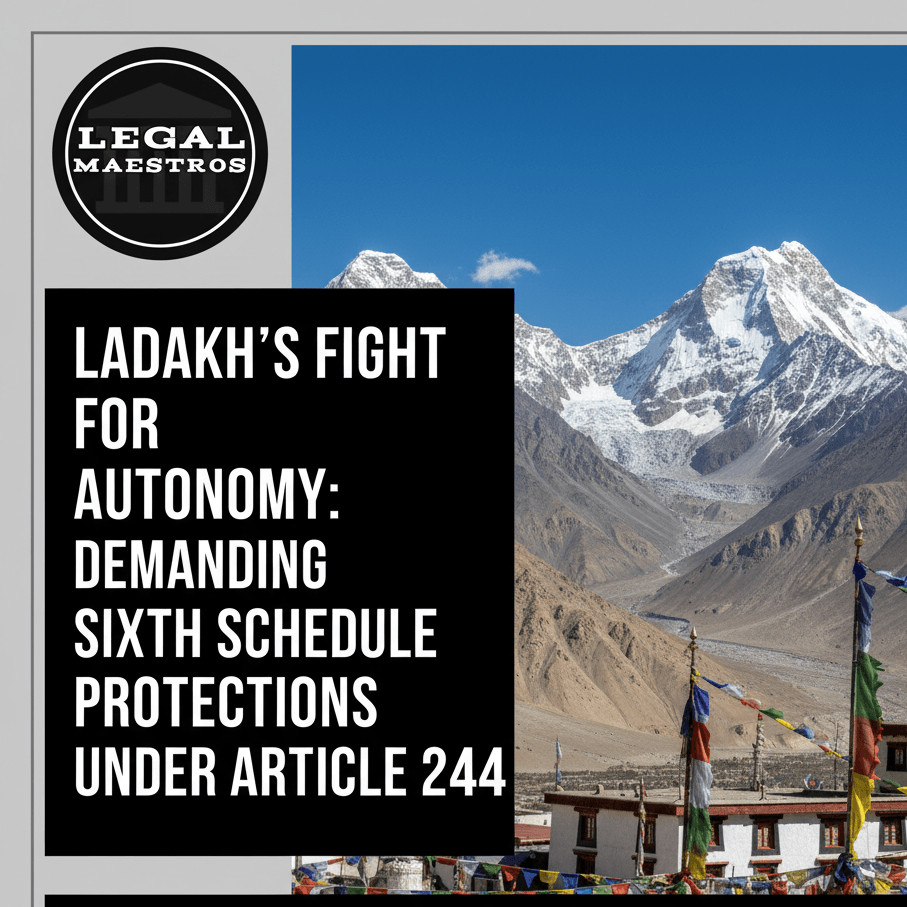
Ladakh's Fight for Autonomy: Demanding Sixth Schedule Protections Under Article 244
A Dream Deferred
There was great celebrations when Ladakh was split off the former state of Jammu and Kashmir and declared a Union Territory on August 5, 2019, particularly in the Leh district. It was a fulfilment of a long time desire of having different identity, but not being affected by political interest of the Kashmir valley. The citizens had hopes that this change would come with development and prosperity directly through the central government so that they can carve their own path.
But then this was replaced by anxiety. The new administrative characterization did not have a legislature, so Ladakh would be governed by bureaucrats who were chosen by the central government. Natives started to be concerned that this model was going to render them powerless, and they would have no authority over their land, resources, employment, and distinctive cultural heritage. The self-government dream began to become distant.
The Shield of the Sixth Schedule
The main agenda of the Ladakhi people is they want to be included in the sixth Schedule which is a special provision of the constitution, in article 244. This plan envisions the formation of Autonomous District Councils (ADCs), which are effective institutions that devolve the tribes into having a high level of control in their own affairs. Such councils are allowed to formulate legislation on matters that are important such as land, forests, local governance, and cultural practices.
For any queries or to publish an article or post or advertisement on our platform, do call at +91 6377460764 or email us at contact@legalmaestros.com.
In the case of Ladakh, where tribal people constitute over 97 percent of the population, this leadership barrier to the constitution is regarded as the key to survival. People worry that in the absence of these measures, a new wave of foreigners will consume their resources, and mega-industrial development will destroy their delicate eco system. The Sixth Schedule is not only a political request, but it is an appeal to save a lifestyle that has been in harmony with nature ever since time has known.
A United Front for Autonomy
The fact that this movement has never been matched by such a collaboration between two predominant districts of Ladakh, the Buddhist Leh and the Muslim Kargil, is what makes this movement especially relevant. Traditionally, the political differences between these regions have been there, however, the collective interest about the future of Ladakh has united the two. They have entered into a joint front with two prominent representative communities; the Leh Apex Body (LAB) and the Kargil Democratic Alliance (KDA).
This united front has now given out a vivid set of demands to the central government. In addition to being included in the Sixth Schedule, they are demanding complete statehood of Ladakh, separate parliamentary representation of Leh and Kargil, special Public Service Commission to hire people in the area. This solidarity has provided them with a lot of muscular power to their peaceful and organized movement, and it demonstrates that the whole region is united in this struggle. 🕊️
For any queries or to publish an article or post or advertisement on our platform, do call at +91 6377460764 or email us at contact@legalmaestros.com.
The Face of the Peaceful Protest
The movement has been completely non-violent as it has depended on marches, hunger strike, and civil disobedience to express its needs. The great innovator and climate activist, Sonam Wangchuk has been the best-known face behind this struggle.
Wangchuk and other leaders have always stated that struggle of the Sixth Schedule is struggle of preserving the environment and keeping the native culture of Ladakh alive. The demonstrations have been characterized by a high sense of community formation and thousands of individuals have exposed themselves to freezing temperatures in order to express their unity. Such a grassroots participation underscores the extent to which the local people are touched by the issue.
An Ongoing Dialogue
The Indian government in reaction to the rising movement has held a number of talks with the leaders of the LAB and KDA. The Ministry of Home Affairs has discussed to have a middle ground as the region is unique. There are a few protections that have been proposed by the government and more authority to the current Ladakh Autonomous Hill Development Councils.
For any queries or to publish an article or post or advertisement on our platform, do call at +91 6377460764 or email us at contact@legalmaestros.com.
But these offers have yet failed to come close to the fundamental requirements of Sixth Schedule status and statehood and the result is an impasse. The talks have not stopped and the people of Ladakh are determined to press on with their non-violent demand of autonomy with the hope that their voices will be heard.



![JOB POST: Junior Associate at ASM Law Chambers, Jaipur [Freshers]](https://legalmaestros.com/wp-content/uploads/2025/11/Gemini_Generated_Image_8wrxer8wrxer8wrx-768x708.png)

